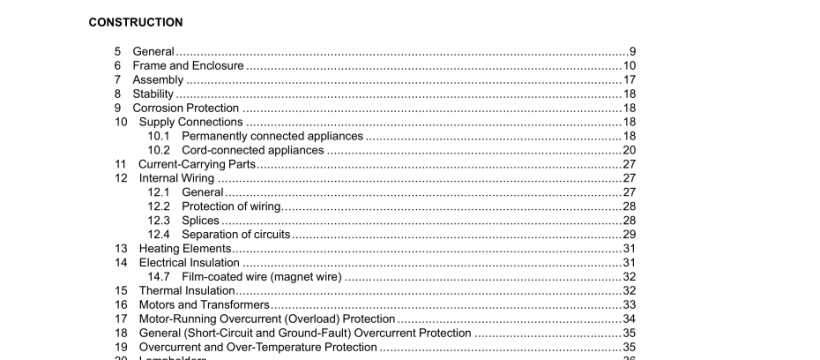UL 1026-2019 pdf download.Household Electric Cooking and Food Serving Appliances.
1 Scope 1.1 These requirements cover household electric cooking and food serving appliances, rated at 250 V or less, other than those mentioned in 1.2, for use in ordinary locations, including appliances intended for casual and permanent outdoor use, in accordance with the National Electrical Code, NFPA 70. 1.2 These requirements do not cover household electric ranges, electrode type appliances, skillets and frying type appliances, fondues, woks, tempuras, corn poppers, coffee makers and brewing type appliances, commercial cooking appliances, microwave cooking appliances, or appliances that are covered in individual requirements that are separate from this Standard. 1.3 For the purposes of this Standard, a requirement that applies to one type of equipment is identified by a specific reference to the type of equipment involved (for example, toaster, rotisserie, or other specific appliance). In the absence of such specific reference or if the term “appliance” is employed, it is to be understood that the requirement applies to all types of equipment covered by the Standard. 1.4 These requirements do not cover slow cookers intended for outdoor use. 2 Units of Measurement 2.1 Values stated without parentheses are the requirement. Values in parentheses are explanatory or approximate information. 3 Undated References 3.1 Any undated reference to a code or standard appearing in the requirements of this standard shall be interpreted as referring to the latest edition of that code or standard.
4.8 CONTROL, MANUAL – A device that requires direct human interaction to activate or rest the control. 4.9 CONTROL, OPERATING – A device or assembly of devices, the operation of which starts or regulates the end product during normal operation. For example, a thermostat, the failure of which a thermal cutout/limiter or another layer of protection would reduce the risk of electric shock, fire, or injury to persons, is considered an operating control. 4.10 CONTROL, PROTECTIVE – A device or assembly of devices, the operation of which is intended to reduce the risk of electric shock, fire or injury to persons during normal and reasonably anticipated abnormal operation of the appliance. For example, a thermal cutout/limiter, or any other control/circuit relied upon for normal and abnormal conditions, is considered a protective control. (During the testing of the protective control/circuit, the protective functions are verified under normal and single-fault conditions of the control.) 4.11 CONTROL, TYPE 1 ACTION – The actuation of an automatic control for which the manufacturing deviation and the drift (tolerance before and after certain conditions) of its operating value, operating time, or operating sequence has not been declared and tested under this Standard. 4.12 CONTROL, TYPE 2 ACTION – The actuation of an automatic control for which the manufacturing deviation and the drift (tolerance before and after certain conditions) of its operating value, operating time, or operating sequence have been declared and tested under this Standard. 4.13 CORD CONNECTOR – A female contact device wired on flexible cord for use as an extension from an outlet to make a detachable electrical connection to an attachment plug or, as an appliance coupler, to an equipment inlet.
5.4 A component not anticipated by the requirements of this end product standard, not specifically covered by the component standards noted in this Standard, and that involves a risk of fire, electric shock, or injury to persons, shall be additionally investigated in accordance with the applicable UL standard, and shall comply with 5.2 (b) – (e). 5.5 With regard to a component being additionally investigated, reference to construction and performance requirements in another UL end product standard is suitable where that standard anticipates normal and abnormal use conditions consistent with the application of this end product Standard. 6 Frame and Enclosure 6.1 The frame and enclosure of an appliance shall be sufficiently strong and rigid to resist the abuses likely to be encountered during intended service. The degree of resistance inherent in the appliance shall preclude total or partial collapse with the attendant reduction of spacings, loosening or displacement of parts, and other serious defects that alone or in combination constitute an increase in the risk of fire, electric shock, or injury. 6.2 An appliance shall be provided with an enclosure of material acceptable for the particular application, which shall house all electrical parts, except for a supply cord, and except for an open-wire-element unit as mentioned in 14.3 and 14.4, that may present a risk of fire, shock, or injury under any condition of use. If an appliance is intended for permanent connection to the power supply, the enclosure shall be provided with means for mounting in the intended manner and shall be furnished with any necessary fittings, such as brackets, hangers, or the like. 6.3 In the case of an appliance employing oil or grease in its normal cooking operation, special consideration shall be given to the need for an enclosure over the cooking compartment, and to the acceptability for the purpose of the material employed for such an enclosure.
UL 1026-2019 pdf download.
UL 1026-2019 pdf download
